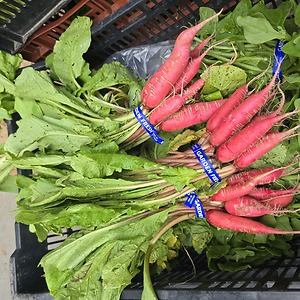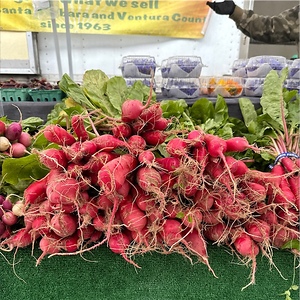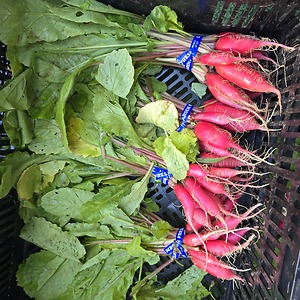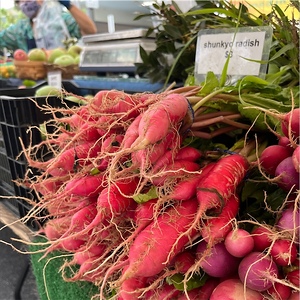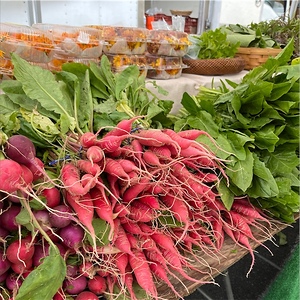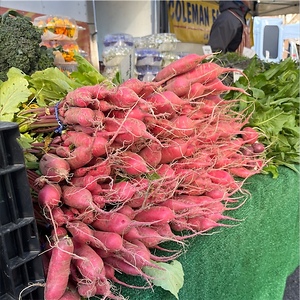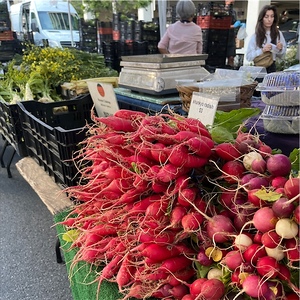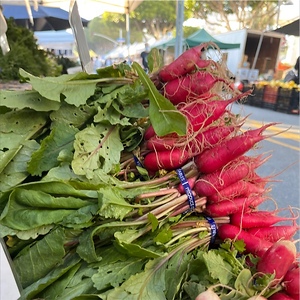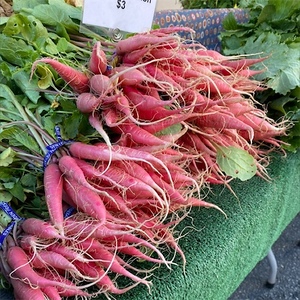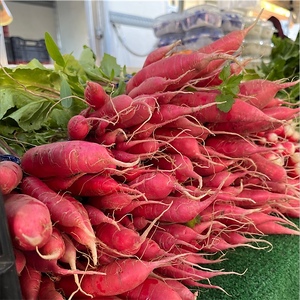

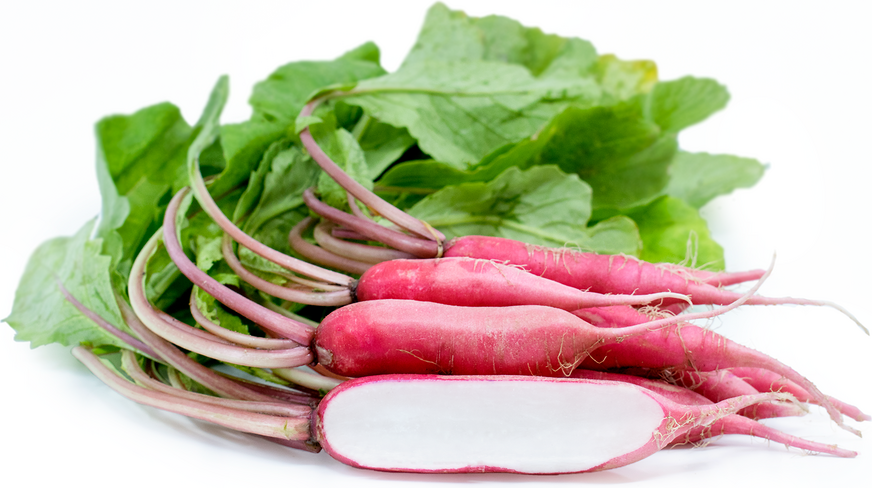
Shunkyo Radish
Estimated Inventory, bunch : 0
Description/Taste
Shunkyo radishes are small to medium roots, averaging 10 to 13 centimeters in length and 3 to 5 centimeters in diameter, and have a long, cylindrical shape, tapering towards the non-stem end. The root’s skin is semi-thin, smooth, and bright red to pink, sometimes covered in a few fine root hairs. Underneath the surface, the white flesh is firm, dense, aqueous, and crisp, offering a crunchy, snap-like consistency. Shunkyo radishes have a sweet, neutral, and earthy flavor followed by a spicy pungency. In addition to the roots, the green leaves are broad, smooth, tender, and edible with a vegetal, peppery taste. The stems also offer magenta to light red hues, providing ornamental contrast.
Seasons/Availability
Shunkyo radishes are available year-round, with a peak season in the spring.
Current Facts
Shunkyo radishes, botanically classified as Raphanus sativus, are an ancient Chinese variety belonging to the Brassicaceae family. The elongated radishes were a widely cultivated radish in its native land of Northern China, and over time, the variety was spread in cultivation, favored for its hardy nature and ability to be grown in warmer weather. In the modern-day, Shunkyo radishes are commercially grown in Asia and are also planted in home gardens, favored by gardeners for their smooth, crisp flesh, sweet and hot flavor, and brightly contrasting skin and flesh. The radish variety is also fast-growing, maturing in approximately 32 days, and is dual-purpose, producing edible leaves and roots. Shunkyo radishes are versatile and can be prepared in any dish calling for radishes. The roots can be consumed fresh or cooked and provide a robust flavoring well suited for main dishes, appetizers, and side dishes.
Nutritional Value
Shunkyo radishes are a good source of fiber to regulate the digestive tract and vitamin C to strengthen the immune system while reducing inflammation. The roots also provide potassium to balance fluid levels within the body and lower amounts of folate, iron, and vitamin B6. In Traditional Chinese Medicine, radishes are prepared in decoctions and are consumed as a digestive aid and to reduce phlegm and congestion. Shunkyo radish leaves are an excellent source of vitamin C and contain calcium and phosphorus to protect bones and teeth, vitamin A to maintain healthy organ functioning, and iron to develop the protein hemoglobin for oxygen transport through the bloodstream.
Applications
Shunkyo radishes have a unique sweet and spicy flavor well suited for fresh and cooked preparations. The roots can be consumed with or without their skin, depending on preference, and the flesh can be thinly sliced and tossed into green salads. Shunkyo radishes can also be grated into coleslaws, sliced in half and served on appetizer platters with dips, juiced, used as a fresh topping over tacos, or cut and layered as a bright addition to crostini, wonton crisps, and toasted bread with butter. In addition to appetizer plates, Shunkyo radish slices contribute a spicy bite to sushi and sashimi, added crunch in wraps and sandwiches, and enhanced flavor in stews and soups. The radishes will also develop a tender texture when roasted, sautéed, braised, or stir-fried, and the roots can be sliced and pickled as a tangy condiment. Beyond the roots, Shunkyo radish leaves are edible and are popularly incorporated into stir-fries, soups, noodle dishes, sandwiches, salads, and as a cooked side dish. Shunkyo radishes pair well with other spring vegetables, including peas, asparagus, fennel, and fava beans, arugula, turnips, parsley, lemongrass, chives, meats such as poultry, beef, and pork, and nuts such as pistachios, almonds, and walnuts. Whole, unwashed Shunkyo radishes will keep 1 to 2 weeks when stored in the refrigerator. The leaves should also be separated from the roots and are more delicate, lasting up to one week in the fridge.
Ethnic/Cultural Info
In Qingdao, China, radishes are celebrated during the Qingxi Temple Fair, also known as the Qingdao Radish Fair. The festival dates back to the Yuan Dynasty and has been held for over 700 years. The temple fair earned its radish moniker from the roots being a favored crop sold during the event. In the spring, the temple fair is traditionally held around the ninth day of the first lunar month, corresponding with the first day of the spring season. Northern Chinese folklore intertwines radish consumption with spring health, and it is customary to eat a radish on the first day of spring, known as “yao qing” or “biting the green,” to promote disease prevention. Throughout history, many different radish varieties, including Shunkyo radishes, have been sold at the temple fair and food vendors sell both raw and cooked radish dishes. During the festival, there is also the National Radish Carving Contest, a famous event where artists carve intricate sculptures using various radish varieties.
Geography/History
Shunkyo radishes are an open-pollinated, heirloom radish native to Northern China. The exact history of the variety is unknown, but experts believe the cultivar spread across Asia and was popular for its ability to be grown in warm weather, fast-growing nature, and smooth, crisp flesh. Shunkyo radishes were eventually introduced to Europe and North America, where they became a unique home garden cultivar. Today Shunkyo radishes are primarily cultivated in Asia, sold through local markets, distributors, and select grocers. Outside of Asia, the radishes are reserved to specialty growers and home gardens throughout North America, Europe, and Australia.
Recipe Ideas
Recipes that include Shunkyo Radish. One
| Loam Agronomics |
|
Roasted Radish |
| Global Growers |
|
Wilted Arugula Salad, Harukei Turnip Puree, and Pickled Shunkyo Radish on a Wonton Crisp |
| Healthy Times |
|
Shunkyo Radish and Tofu Soup |



